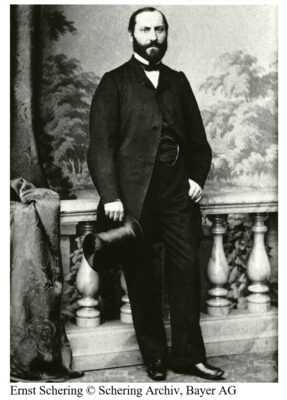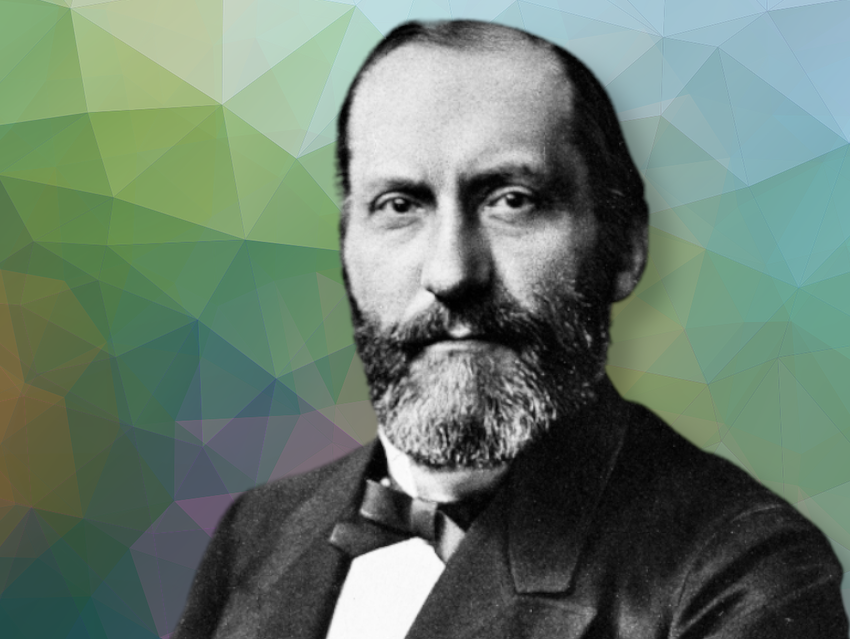Ernst Christian Friedrich Schering was not only a skilled pharmacist but also a visionary entrepreneur whose innovations revolutionized the pharmaceutical industry. He was born on May 31, 1824, in Prenzlau in the German district of Uckermark, the youngest of six siblings.[1] As a trained pharmacist, he played a key role in laying the foundations for a research-based pharmaceutical industry in Germany.
Early Years

As a grammar school student, Schering wanted to become a forester. However, he eventually bowed to the wishes of his family and embarked on a career as a pharmacist. He, however, agreed on his own terms. He insisted on learning from the best, and chose the famous Apelius pharmacy “Zum schwarzen Adler” in Berlin, Germany, as his training school. He carried out his apprenticeship there from 1841–44.
Even during his education, Schering developed an ambition to produce only preparations of the highest purity. At that time, what pharmacists offered their customers was usually produced in their own laboratories, as there was still no significant chemical and pharmaceutical industry.
After his training, Schering travelled to Westphalia and the Rhineland to gain experience, as was then customary. In 1847, he began working in a pharmacy for the poor in Aachen. During the revolution of 1848, he was in Recklinghausen. By this time, he was already concerned with the responsibility of his profession, which seemed to him to play an important role in the care of patients. He, therefore, reacted with concern to the revolutionaries’ demands for complete freedom of trade and wrote to his brother, “What nonsense: the pharmacist becomes a grocer, the patient an object of exploitation and science goes to the dogs.”[2]
Back in Berlin, Schering studied chemistry, physics, and botany. In 1850, he passed the state examination as a “first-class pharmacist” with “very good”, married and worked in various Berlin pharmacies until he was sworn in as a state-recognized pharmacist.
He was a co-signatory of the Statutes of the Corporation of Berlin Pharmacists of April 2, 1851, which later became the Association of Berlin Pharmacists.
“Grüne Apotheke“ and Innovative Contributions to Photography
On July 1, 1851, he bought a pharmacy in Chausseestrasse in Berlin with the financial support of his family and a friend, as well as two mortgages left on the property.[3] It was located between tenement blocks in the middle of an industrial area known as “Feuerland” (“fire land”) because of its many chimneys. Whether out of hope or because that was the name of the pharmacy in his hometown of Prenzlau, Schering renamed it the “Grüne Apotheke” (“Green Pharmacy”).
Here he began to produce chemicals for his pharmaceutical products and looked to specialize his business. He observed the spread of the new art of photography and realized that many of the resulting images were of poor quality, due to the impurities in the chemicals used. When analyzing imported chemicals, he discovered that the photographic technique for producing plates and images only promised success if chemicals of high purity were used. So, he identified the deficiencies, experimented and produced in his own shop iodine and bromine salts, potassium cyanide, pyrogallic acid, collodion wool, etc. The “Grüne Apotheke” was soon regarded as the top address for photo chemicals.[4]
In 1855, Schering presented his products at the Paris World Exhibition, where he won a silver medal for the purity of his preparations.
Founding the Chemical Factory
After some minor mishaps in the cramped premises of the pharmacy, Schering finally bought a plot of land at Müllerstrasse 171, Berlin, in 1858. Twenty-five meters wide, it ran 250 meters in the direction of Nordhafen and is still part of the former Schering AG site, which was taken over by Bayer in 2006.
At that time, it was located just outside the city limits. The new site was occupied in 1864, and he opened the “Chemische Fabrik E. Schering”. In addition to production, a technical laboratory was set up to develop industrial manufacturing processes for chemical and pharmaceutical products. As it was important to Schering to retain entrepreneurial control over the entire business and all phases of production, the officially authorized product range in the opening year was comparatively modest:
1) Bromine alhydrat, obtained by the action of bromine on alcohol, annual production 10 to 12 pounds.
2) Elayl chlorür and ethylene chloride, obtained by fractionation of chlorinated ethyl chloride, 25 to 30 pounds per year.
3) Chloroform and chloral, obtained by decomposition of chloral hydrate and fractionation, 35 to 40 pounds per year.
4) to 7) Acetone chloral hydrat, nitric acid, hydrochloric and acetic acid, chloral hydrate crystallised or cast in tablets; phenol.
In addition, there were the fine chemicals that had already been produced in large quantities at the “Grüne Apotheke”.[4]
[The terms “Brom alhydrat,” “Elayl chlorür,” and “Aceton chloral hydrat” reflect historical chemical nomenclature that has since been standardized in modern chemistry as bromoform, ethyl chloride, and chloral acetone, respectively.]
Schering continued to train employees himself, as there were still no prescribed training programs for laboratory technicians and chemists. In addition to his entrepreneurial activities, he maintained close contacts with leading chemists, and published results from his own practice in scientific journals. Alongside August Wilhelm von Hofmann, he was a co-founder of the German Chemical Society, of which he remained treasurer until 1880.
During the Franco-Prussian War of 1870/71, the chemical factory was entrusted with supplying several army corps with medical pharmaceuticals. After the end of the war and the foundation of the German Reich, in October 1871 Schering converted his factory into a stock corporation: it was now called the “Chemische Fabrik auf Actien (vormals E. Schering)”. He himself remained the only member of the Board of Management until 1874, and the Supervisory Board was made up of many pharmacists. Schering resigned from the Board of Management in 1882 but remained on the Supervisory Board until his death on 27 December, 1889.
His company, in which no family members were active, continued to grow, becoming Schering AG with its global reputation.
Appreciation
“E. Schering is actually a pioneer in the field of the chemical industry […] The initially very limited workshops soon had to be expanded, and after just a few years the man’s manufacturing activities had conquered the world market. The extent of the industrial operations founded by Schering […] is widely known in chemical circles. In the midst of this grueling business activity, the immortalized man always retained a lively interest in the progress of science; he was always ready to put the rich resources of his magnificent workshops at the service of research.” A. W. Hoffmann, obituary of Ernst Schering [5].
Postcript
The history of the Schering company is researched and preserved in the Schering Archives, a branch of Corporate History & Archives of Bayer AG. The documents in the archive provide insight into the company’s history since its beginnings with the “Grüne Apotheke”. Until its acquisition by Bayer in 2006, Schering was an independent, publicly traded pharmaceutical company with more than 25,000 employees in 160 subsidiaries worldwide and sales of approximately €5.3 billion (2005). Its headquarters were in Berlin-Wedding, where “Chemische Fabrik E. Schering” started.
Today, the Berlin-based Schering Stiftung keeps Ernst Schering’s visionary pioneering spirit alive. As a supporter of science and the arts and an active bridge-builder between the disciplines, it is the last bearer of the name.
References
[1] Christine Berghausen, Schering, Ernst Christian Friedrich, Neue Deutsche Biographie 2005, 22, 697–698.
[2] E. Schering to August Schering (1848 May 20), Historisches Archiv Scheringianum, Berlin, quoted from: Wlasich, Gert J., “Über Ernst Schering“ in Ernst Schering, “Reisen 1876–78. Tagebücher“, Schriftenreihe Scheringianum 2001, p. 72.
[3] Berghausen op. cit.
[4] Gert J. Wlasich, “Über Ernst Schering“ in Ernst Schering, “Reisen 1876–78. Tagebücher“, Schriftenreihe Scheringianum 2001, p. 74.
[5] Quoted from: Reports of the German Chemical Society, Volume XXIII, Meeting of January 13, 1890.
- Ernst Schering is the answer to Guess the Chemist (150).




